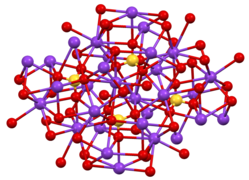 | |
 | |
| Names | |
|---|---|
| IUPAC name Potassium chromate | |
| Other names Potassium dichromate, Chromic acid, (K2CrO4), dipotassium salt | |
| Identifiers | |
3D model (JSmol) | |
| ChEBI | |
| ChemSpider | |
| ECHA InfoCard | 100.029.218 |
| EC Number |
|
PubChem CID | |
| RTECS number |
|
| UNII | |
| UN number | 3077 |
CompTox Dashboard (EPA) | |
| |
| |
| Properties | |
| K2CrO4 | |
| Molar mass | 194.189 g·mol−1 |
| Appearance | Yellow powder |
| Odor | odorless |
| Density | 2.7320 g/cm3 |
| Melting point | 968 °C (1,774 °F; 1,241 K) |
| Boiling point | 1,000 °C (1,830 °F; 1,270 K) |
| |
| 3.9×10−6 cm3/mol | |
Refractive index (nD) | 1.74 |
| Structure | |
| rhombic | |
| Hazards | |
| GHS labelling: [1] | |
   | |
| Danger | |
| H315, H317, H319, H335, H340, H350, H410 | |
| P201, P202, P261, P264, P271, P272, P273, P280, P302+P352, P304+P340+P312, P305+P351+P338, P308+P313, P333+P313, P337+P313, P362, P391, P403+P233, P405, P501 | |
| NFPA 704 (fire diamond) | |
| Safety data sheet (SDS) | Fisher Scientific [2] |
| Related compounds | |
Other anions | Potassium dichromate |
Other cations | |
Related chromates | |
Except where otherwise noted, data are given for materials in their standard state (at 25 °C [77 °F], 100 kPa). | |
Potassium chromate is the inorganic compound with the formula K2CrO4. This yellow solid is the potassium salt of the chromate anion. It is a common laboratory chemical, whereas sodium chromate is important industrially.



